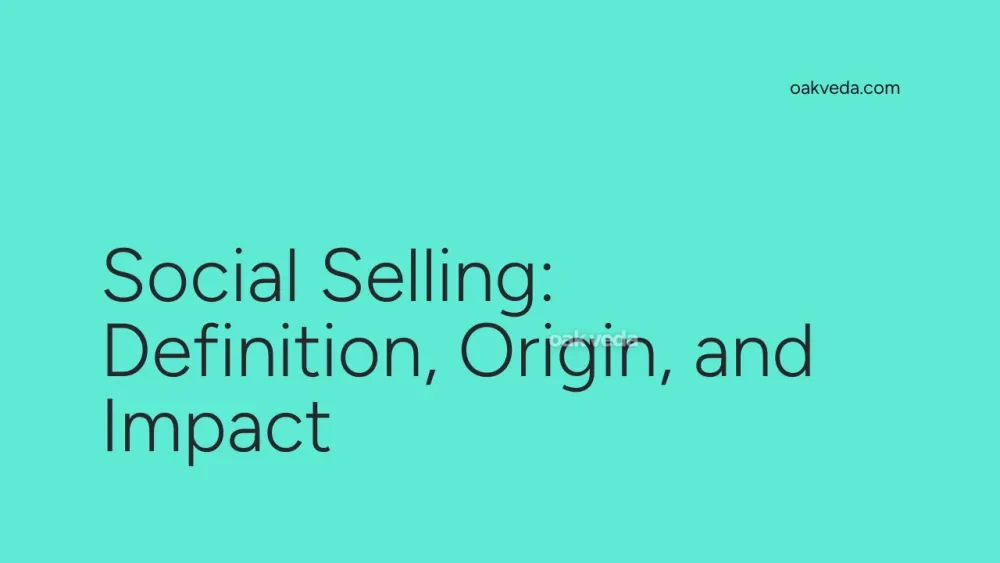
What is Social Selling?
Social selling is a modern sales strategy that harnesses the power of social media platforms to identify, connect with, and nurture potential customers. This approach goes beyond traditional sales tactics by focusing on relationship-building and providing value through digital interactions. Social selling involves creating a strong personal brand, sharing relevant content, and engaging with prospects in meaningful ways across various social networks.
Origin and Development of Social Selling
The concept of social selling emerged in the early 2010s as social media platforms gained prominence in both personal and professional spheres. As businesses recognized the potential of these platforms for reaching and engaging with their target audience, sales professionals began to adapt their strategies accordingly. The term "social selling" was coined to describe this new approach that blended social media marketing with traditional sales techniques.
How Social Selling Works
Social selling operates on the principle of building trust and credibility through online interactions. Here's a breakdown of the key components:
-
Personal Branding: Sales professionals create and maintain a strong online presence that showcases their expertise and industry knowledge.
-
Content Sharing: Sharing valuable, relevant content that addresses the pain points and interests of potential customers.
-
Engagement: Actively participating in online discussions, commenting on posts, and answering questions to establish relationships.
-
Listening and Monitoring: Using social media monitoring tools to identify potential leads and understand their needs.
-
Relationship Building: Nurturing connections over time by providing consistent value and personalized interactions.
-
Lead Generation: Identifying and qualifying potential customers through social media interactions and shared connections.
-
Sales Conversion: Moving relationships from social platforms to more direct communication channels to close deals.
Types of Social Selling
Social selling can be categorized based on the target audience and the platforms used:
-
B2B Social Selling: Focuses on building relationships with decision-makers in other businesses, often utilizing platforms like LinkedIn and Twitter.
-
B2C Social Selling: Targets individual consumers, typically using platforms such as Facebook, Instagram, and Pinterest.
-
Industry-Specific Social Selling: Tailors approaches to niche markets or specific industries, sometimes using specialized professional networks.
Popular Examples of Social Selling
-
LinkedIn Sales Navigator: A tool designed specifically for social selling on LinkedIn, helping sales professionals find and engage with the right prospects.
-
Twitter Chats: Participating in or hosting industry-specific Twitter chats to demonstrate expertise and connect with potential customers.
-
Instagram Stories: Brands and sales professionals using Instagram Stories to showcase products, share behind-the-scenes content, and engage with followers in real-time.
-
Facebook Groups: Creating or participating in industry-specific Facebook Groups to provide value and build relationships with potential customers.
Impact of Social Selling on Social Media Culture
Social selling has significantly influenced social media culture by:
- Blurring the lines between personal and professional content
- Encouraging more authentic and value-driven interactions between businesses and consumers
- Shifting the focus from hard-selling to relationship-building and education
- Increasing the demand for high-quality, industry-specific content on social platforms
Controversies or Debates Surrounding Social Selling
While social selling has proven effective, it's not without its challenges:
- Privacy Concerns: Some users feel that social selling intrudes on their personal space on social media.
- Authenticity Issues: There's a fine line between genuine relationship-building and manipulative sales tactics.
- Measurement Difficulties: Quantifying the ROI of social selling efforts can be challenging.
- Platform Limitations: Some social networks have implemented restrictions on certain sales activities to maintain user experience.
How Brands and Influencers Use Social Selling
Brands and influencers leverage social selling by:
- Creating and sharing valuable content that addresses customer pain points
- Engaging in social listening to identify and respond to potential leads
- Collaborating with industry thought leaders to expand reach and credibility
- Using social proof, such as customer testimonials and case studies, to build trust
- Implementing social CRM tools to track and nurture relationships
Future Trends Related to Social Selling
As social selling continues to evolve, several trends are emerging:
- AI-Powered Personalization: Using artificial intelligence to tailor social selling approaches to individual prospects.
- Video Content: Increasing use of live video and short-form video content for engagement and demonstrations.
- Social Commerce Integration: Seamless integration of e-commerce features within social platforms.
- Employee Advocacy: Empowering employees to become brand ambassadors through their personal social networks.
- Data-Driven Strategies: Leveraging advanced analytics to refine social selling tactics and improve conversion rates.
FAQs about Social Selling
-
Is social selling only effective for B2B companies? No, while it's particularly effective in B2B contexts, social selling can also be successful in B2C scenarios when adapted appropriately.
-
What's the difference between social selling and social media marketing? Social selling focuses on individual sales professionals building relationships, while social media marketing typically involves broader brand-level strategies and campaigns.
-
Which social media platforms are best for social selling? LinkedIn is often considered the top platform for B2B social selling, while Facebook and Instagram can be effective for B2C. The best platform depends on where your target audience is most active.
-
How can I measure the success of my social selling efforts? Key metrics include Social Selling Index (SSI), engagement rates, lead generation, and ultimately, revenue attributed to social selling activities.
-
Is social selling replacing traditional sales methods? Social selling is complementing rather than replacing traditional methods. It's most effective when integrated into a comprehensive sales strategy that includes both online and offline tactics.
By embracing social selling, businesses and sales professionals can tap into the vast potential of social networks to build meaningful relationships, establish thought leadership, and drive sales in an increasingly digital world.
You may be interested in:
- Online Community: Definition, Origin, and Impact
- Girl Math: Definition, Origin, and Impact on Social Media
- BeReal: Definition, Origin, and Impact on Social Media
- Boyfriend Effect: Definition, Origin, and Impact on TikTok
- FR (For Real): Definition, Origin, and Impact on Social Media
- Finna: Definition, Origin, and Impact on Social Media

